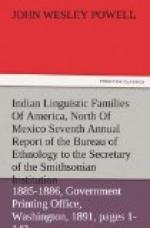[Footnote 26: In 1719,
fide Margry, VI, 289, “the Ousita village
is on the southwest branch
of the Arkansas River.]
[Footnote 27: 1805, in Lewis and Clarke, Discov., 1806, p. 66.]
[Footnote 28: Second Mass, Hist. Coll., vol. 2, 1814, p. 23.]
[Footnote 29: 1690, in French, Hist. Coll. La., vol. 1, p. 72.]
[Footnote 30: 1719, in Margry, vol. 6, p. 264.]
PRINCIPAL TRIBES.
A. Pawnee.
Grand Pawnee.
Tappas.
Republican Pawnee.
Skidi.
B. Arikara.
C. Wichita.
(Ki-ci’-tcac, Omaha
pronunciation of the name of a Pawnee tribe,
Ki-dhi’-chash
or Ki-ri’-chash).
D. Kichai.
E. Caddo (Kae’-do).
Population.—The present number of the Caddoan stock is 2,259, of whom 447 are on the Fort Berthold Reservation, North Dakota, and the rest in the Indian Territory, some on the Ponca, Pawnee, and Otoe Reservation, the others on the Kiowa, Comanche, and Wichita Reservation. Below is given the population of the tribes officially recognized, compiled chiefly from the Indian Report for 1889:
Arikara
448
Pawnee
824
Wichita
176
Towakarehu
145
Waco
64
—–
385
Kichai
63
Caddo
539
-----
Total
2,259
CHIMAKUAN FAMILY.
= Chimakum, Gibbs in Pac. R. R. Rep., I, 431, 1855 (family doubtful).
= Chemakum, Eells in Am. Antiquarian,
52, Oct., 1880 (considers
language different from any of its neighbors).
< Puget Sound Group, Keane, App.
Stanford’s Comp. (Cent. and So. Am.),
474, 1878 (Chinakum included in this group).
< Nootka, Bancroft, Native Races, III, 564, 1882 (contains Chimakum).
Derivation unknown.
Concerning this language Gibbs, as above cited, states as follows:
The language of the Chimakum “differs materially from either that of the Clallams or the Nisqually, and is not understood by any of their neighbors. In fact, they seem to have maintained it a State secret. To what family it will ultimately be referred, cannot now be decided.”
Eells also asserts the distinctness of this language from any of its neighbors. Neither of the above authors assigned the language family rank, and accordingly Mr. Gatschet, who has made a comparison of vocabularies and finds the language to be quite distinct from any other, gives it the above name.




